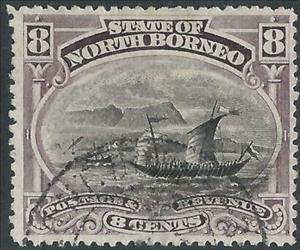Stamp: Malay Dhow (North Borneo 1894)
Malay Dhow (North Borneo 1894)
01 January (North Borneo ) within release Pictorial Definitives 1894-1896 goes into circulation Stamp Malay Dhow face value 8 British North Borneo cent
| Stamp Malay Dhow in catalogues | |
|---|---|
| Stanley Gibbons: | Sg: NB 74b |
Stamp is square format.
Perforation can vary between 13½ and 14 on this stamp due to variations in the perforating machinery used by the printer. Stamps with cancellations consisting of a grid of bars are remainders of minimal value compared to stamps with clear postal cancellations.Also in the issue Pictorial Definitives 1894-1896:
- Stamp - Sago Palm face value 3;
- Stamp - Saltwater Crocodile (Crocodylus porosus) face value 12;
- Stamp - Mt. Kinabalu face value 18;
- Stamp - Coat Of Arms face value 6;
- Stamp - Sago Palm face value 3;
- Stamp - Dyak chief face value 1;
- Stamp - Dyak chief face value 1;
- Stamp - Coat of Arms with Supporters face value 24;
- Stamp - Sambar Deer (Cervus unicolor) face value 2;
- Stamp - Coat Of Arms face value 6;
- Stamp - Mt. Kinabalu face value 18;
- Stamp - Dyak chief face value 1;
- Stamp - Great Argus Pheasant (Argusianus argus) face value 5;
- Stamp - Sambar Deer (Cervus unicolor) face value 2;
- Stamp - Saltwater Crocodile (Crocodylus porosus) face value 12;
- Stamp - Saltwater Crocodile (Crocodylus porosus) face value 12;
- Stamp - Dyak chief face value 1;
- Stamp - Sambar Deer (Cervus unicolor) face value 2;
- Stamp - Mt. Kinabalu face value 18;
- Stamp - Malay Dhow face value 8;
- Stamp - Malay Dhow face value 8;
- Stamp - Sambar Deer (Cervus unicolor) face value 2;
- Stamp - Saltwater Crocodile (Crocodylus porosus) face value 12;
- Stamp - Great Argus Pheasant (Argusianus argus) face value 5;
- Stamp - Dyak chief face value 1;
- Stamp - Coat Of Arms face value 6;
- Stamp - Sambar Deer (Cervus unicolor) face value 2;
- Stamp - Sago Palm face value 3;
- Stamp - Great Argus Pheasant (Argusianus argus) face value 5;
- Stamp - Dyak chief face value 1;
- Stamp - Dyak chief face value 1;
- Stamp - Dyak chief face value 1;
- Stamp - Great Argus Pheasant (Argusianus argus) face value 5;
- Stamp - Sago Palm face value 3;
- Stamp - Coat of Arms with Supporters face value 24;
- Stamp - Sago Palm face value 3;
|
Data entry completed
56%
|
|
|---|---|
| Stamp Malay Dhow in digits | |
| Country: | North Borneo |
| Date: | 1894-01-01 |
| Print: | Recess |
| Perforation: | 13½ |
| Emission: | Definitive |
| Format: | Stamp |
| Face Value: | 8 British North Borneo cent |
Stamp Malay Dhow it reflects the thematic directions:
A modern sailing ship or sailship is any large wind-powered vessel. Traditionally a sailing ship (or simply ship) is a sailing vessel that carries three or more masts with square sails on each. Large sailing vessels that are not ship-rigged may be more precisely referred to by their sail rig, such as schooner, barque (also spelled "bark"), brig, barkentine, brigantine or sloop. There are many different types of sailing ships, but they all have certain basic things in common. Every sailing ship has a hull, rigging and at least one mast to hold up the sails that use the wind to power the ship. The crew who sail a ship are called sailors or hands. They take turns to take the watch, the active managers of the ship and her performance for a period. Watches are traditionally four hours long. Some sailing ships use traditional ship's bells to tell the time and regulate the watch system, with the bell being rung once for every half hour into the watch and rung eight times at watch end (a four-hour watch). Ocean journeys by sailing ship can take many months, and a common hazard is becoming becalmed because of lack of wind, or being blown off course by severe storms or winds that do not allow progress in the desired direction. A severe storm could lead to shipwreck, and the loss of all hands. Sailing ships are limited in their maximum size compared to ships with heat engines, so economies of scale are also limited. The heaviest sailing ships (limited to those vessels for which sails were the primary means of propulsion) never exceeded 14,000 tons displacement. Sailing ships are therefore also very limited in the supply capacity of their holds, so they have to plan long voyages carefully to include many stops to take on provisions and, in the days before watermakers, fresh water.

